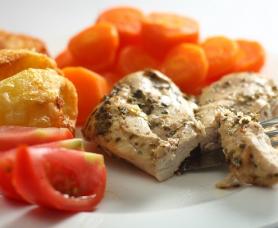Theory
The term Macrobiotics is derived from the Greek words for “large” and “life.”
A macrobiotic diet consists of raw and natural foods and at times referred to as a vegan diet but some will incorporate organic meats and fish. Many followers of macrobiotics believe that preservatives and additives in manufactured foods are harmful to the body thus making the body more susceptible to disease.
Committing to a macrobiotic diet involves that you change your diet to wholesome, vegetarian fare and practicing certain aspects of Buddhism like meditation and slowing down your way of life. You will consume organic, locally grown seasonal foods which are energetically balanced (yin and yang).
Celebrities like Gwenyth Paltrow and Madonna have turned to a macrobiotic way of eating to maintain their slim physiques and good health.
How Do I Follow It?
Foods are designated either as yin (expansion) or yang (contraction) by four factors:
- How the food grows,
- where the food was grown,
- Sodium-potassium content, and
- The effect the food has on the body (hot or cold effects).
- Turkey (yang) with Cranberry Sauce (yin)
- Corned Beef (yang) with Sauerkraut (yin)
- Eggs (yang) with Tomatoes (yin)
A standard macrobiotic diet will consist of whole grains, round vegetables, sea vegetables, root vegetables, leafy greens, beans, local fruit and juice, and white meat fish along with soups like miso, tamari (shoyu) broth and vegetable soup.
Foods are cooked differently depending on the season. The best cooking methods are: boiling, blanching, pressure cooking, steaming, stewing, water sautéing, marinating, and pickling. Try to avoid baking, stir frying, deep frying, oil sautéing, tempura, dry roast, and barbecue.
A spring macrobiotic diet daily menu may look like this:
Breakfast: Whole oat groats with blanched collards and ume vinegar
Lunch: Lentil soup with greens and marinated tempeh and pickled mushrooms
Snack: Pan-fried polenta sticks
Dinner: Brown rice burgers, garlicky garbanzo beans, steamed baby bok choy with shoyu.
So what foods do you need to avoid or eat limited amounts of while following macrobiotics? Basically foods that are extreme “yin” or extreme “yang.” This includes red meat, poultry, fatty foods, eggs, sugar, salt, alcohol, coffee and dairy products. All processed foods that have been artificially colored, preserved, sprayed, or chemically treated are best to be completely avoided.
Many people who practice a macrobiotic diet often practice “wholistic” living where they seek wholeness in spirit, mind and body. This often includes spiritual practice, exercise and holistic medicine along with following a regular set schedule such as maintaining regular waking, eating and sleeping times.
Benefits
Eating a variety of wholesome natural foods like whole grains, vegetables, and beans can potentially lower your risk for heart disease and certain cancers. The diet promotes sustainability by eating seasonal foods for maximal freshness and helps to reduce costs; economically and energy consumption from fossil fuels.
Criticism
For some, the macrobiotic diet can be quite time-consuming in preparing the healthy meals. If not done properly, this diet can lead to nutrient deficiencies; lacking in vitamins B12 and D along with iron, calcium, and protein.
By eliminating healthy foods like dairy and eggs, you lose out on their nutritional benefits and no supplementation is allowed.
Does "The Macrobiotic Diet" Work?
If you want to eat like our ancestors did before chemical fertilizers, processed and bioengineered foods while limiting greenhouse gases, macrobiotics is probably the best way to go.
Eating locally grown foods will help the environment by limiting emissions from foods traveling great distances. Also organic foods are better for you and the environment; just make sure you eat well balanced and get plenty of healthy fats and lean protein to meet your needs.
Where To Buy "The Macrobiotic Diet"?
There are plenty of books on the market showcasing the benefits of a macrobiotic diet. Learn more about the macrobiotic lifestyle and how to implement with your very own copy of The Everything Guide to Macrobiotics.

















